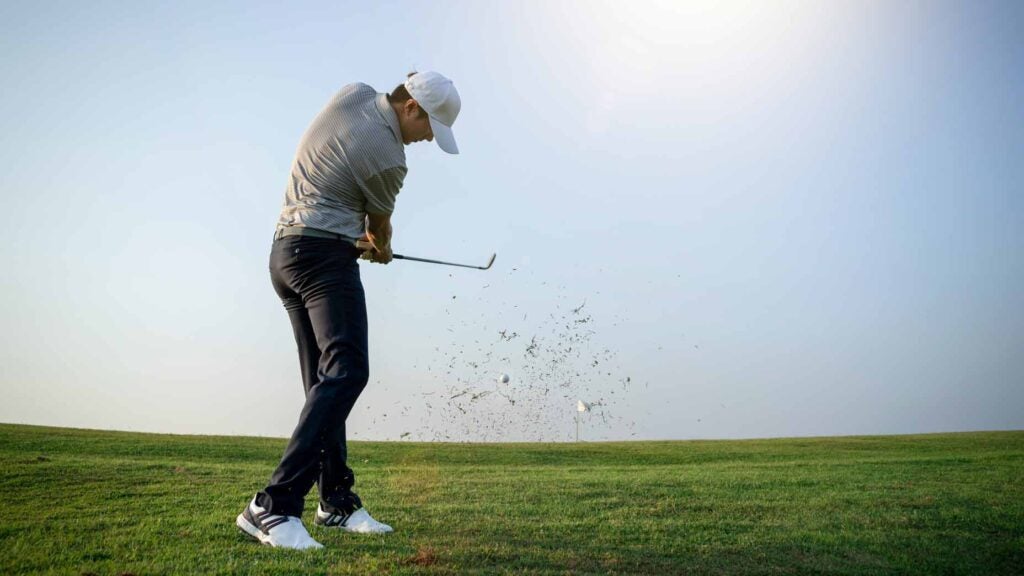A pro golfer who controls wedge trajectory makes it look so easy. They’re able to either hit their wedges high and spinning, or low and running out on demand — which is fun to watch for amateur players.
While it may appear difficult for an amateur to duplicate what the pros are doing with their wedges, with a little understanding and practice you can do something similar.
For those amateur golfers looking to improve their wedge trajectory — increasing their control while still making solid contact — here are 10 tips to start seeing success.
1. Contact
Good golf seems to always start with good contact.
When it comes to using your wedges, hitting it square and in the center of the clubface will provide more control of direction, distance and trajectory — which is true for all types of clubs.
And, while it may feel basic, good posture will help you make good contact. By bending your hips and allowing your hands to hang below the shoulders, you’ll be able to get the club down to the ground and the ball in the center of the clubface.
2. Club selection
The most obvious way to control flight and trajectory with your wedges is with club selection.
If I want to hit the ball higher, I’m going to use a more lofted wedge — like a 58- or 60-degree wedge. If I want the ball to go lower and roll more, I may choose a pitching wedge.
Rather than forcing something that isn’t natural, it can be much easier to just change your selected club.
3. Ball position
By adjusting your ball position, you’ll be able to change the shaft angle at impact. This will help with the loft of the golf ball, converting it to different flight and roll ratios.
Be careful with where you set up, though.
By putting the ball slightly back in your stance, the clubface will be less lofted, causing the flight of the ball to come out lower and roll more. But if you play your ball slightly more forward, the club shaft will be more straight up and down, causing a more lofted shot that spins more and rolls less.
4. When looking for a higher shot, turf interaction is pivotal
In order to get flight with your wedges, you need to make solid contact with both the ball and then the turf. Too many amateurs shy away from turf interaction out of fear, thinking they’ll chunk the ball. But you need to be willing to hit the ground to get the ball in the air.
5. Lower shots can survive a mishit
Since a lower shot doesn’t require as large of a swing, there is a little more insurance in case you mishit and don’t make perfect contact with the ball.
If your lower shots are hit a little thin, they can often be quite playable. This is a good reason to use a lower-lofted club, which will produce a running option. If you do this, be sure to have a slight lean toward the target and a more connected and rotary motion in the upper body.
6. Shaft angle impacts your short game shots
A club shaft that is more up-and-down and neutral will produce higher launching shots that don’t roll as much. On the contrary, if your club shaft is leaning more toward the target at impact, the effective loft will be decreased, which produces a lower flight that will release and roll more upon landing.
7. Get your thumbs up when going high
In order to produce a more steep angle of attack — which will cause leverage in your backswing for a high pitch shot — you’ll need to get your thumbs pointing up on your backswing.
When your thumbs are up this way, they act as a lever. This allows the club to fall down the back of the ball, so that the flighted wedge will be higher and softer.
8. Get your thumbs down when going low
If you’re looking to hit a lower shot that runs more, you’ll be using more of the whole arm — so your thumbs must point down through the entire stroke. This will help create more square and direct contact with the back of the ball.
9. Your body release when going low
Changing your release patterns will help create the desired flight for your wedges. If you allow your body to be more involved with your forward swing, your club shaft will tend to be more forward-leaning. This produces a lower shot that will roll more once it hits the putting surface.
10. Your club head release for going high
When you allow the clubhead to swing freely — meaning it’s more in line with the handle at impact — the loft of the club will be greater, causing the ball flight to be higher.
For those players looking to launch and spin the ball with a short game wedge, this is a great swing option.
Although many amateurs doubt that they can control their wedge trajectory like pros can, it’s possible to achieve similar results. It all starts with proper club selection, motion, and different release patterns.
So whether you’re looking for a low shot that produces some roll, or trying to hit an impressive high ball with a soft landing, the above techniques will help get your game there much faster.
